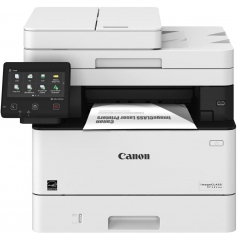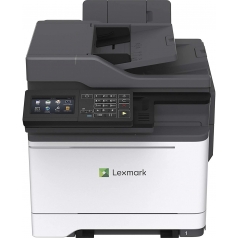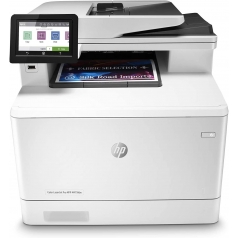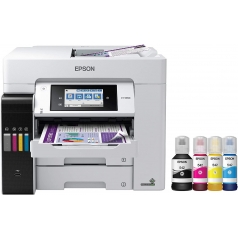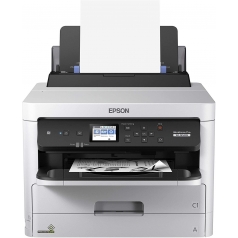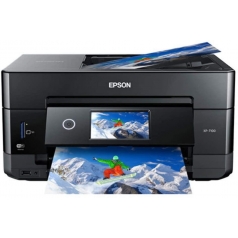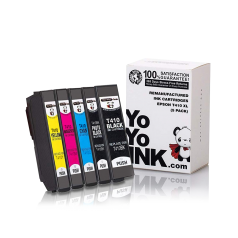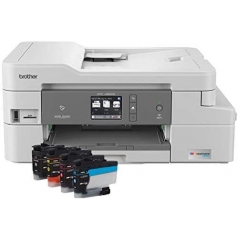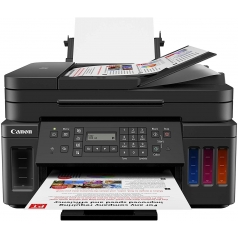A reliable printer is among the crucial devices that any small business should have. Choosing one may sound simple at first, but with the many options and available features you can choose from, it can be quite challenging to pick the right printer.
Will a stand-alone printer suffice for your needs? Or do you need something that can also scan, copy, or fax documents? How can you make sure that you choose the most suitable printer for your small business?
The previous questions are just some of the most common questions that we are going to answer in this guide. So if you want to know more, keep on reading!

What are the Factors to Consider When Purchasing a Printer?
Choosing a printer is the same as choosing any type of technology – you need to take careful consideration. No printer exists that can meet the needs of every business. There are a few factors you need to consider before you can finally choose the best one for your small business:
#1 Used vs. New
When you buy a new printer, you don’t need to worry about repairs and services which can save your business some money. But with used printers, it is obvious that you can save more. There are times that printer dealers stock used printers that are mostly new. These are printers that have been returned by customers quickly because of certain reasons.
#2 Buy vs. Lease
Up-front costs of buying a printer are lower compared to leasing one because you don’t have to worry about potential interests or long-term monthly payments. But with leasing, you can lessen the burden of spending a huge amount of money for a single payment, especially if you have other machines you need to buy.
#3 Your Budget
When setting your budget, consider both the upfront costs and long-term costs:
(a) Upfront Costs
Determine how much you are willing to spend for buying your printer. However, don’t just choose any cheap printer because you might have a problem later on like frequent repairs. Balance quality and price when you pick a printer.
(b) Long-Term Costs
Not all cheap printers are also cheap to maintain. Consider how much you will be spending for other running costs in the future including the following:
-
- Energy consumption
- Maintenance services
- Cartridge replacements
- Supplies
Cartridge replacements are often the most expensive supplies for a printer. Regardless of how cheap or expensive a printer is, cartridges will always be pricey. However, there are cheaper alternatives to OEM cartridges like remanufactured and compatible cartridges.
You can check out YoyoInk’s products if you are looking for affordable ink cartridge replacements for your printer. We have supplies for various printer brands like Canon, Epson, HP, Kodak, and Brother.
#4 Your Office’s Size
The printer you will be buying should fit in your small office and complement the device you are using. For instance, if you are using a laptop, consider buying a portable printer. But if you have extra space in your office, you can buy a bigger printer if you can afford it.
#5 Your Printing Volume
Printers have different printing speeds and monthly duty cycles (more on these in the next section). So before you choose a printer, know how often you will be printing to make sure that the printer you will be buying can handle your printing demands.
#6 Type of Printer
There are many types of printers you can choose from, depending on what you are looking for. The most common ones are discussed below:
(a) Laser vs. Inkjet
The major difference between laser and inkjet printers is that laser printers use lasers while inkjet printers use ink. Below are the key applications of each type of printer:
Laser Printers
Laser printers are for businesses that:
- Don’t mind expensive up-front costs for toner cartridges (toner cartridges are more expensive compared to ink cartridges but they can last longer)
- Have larger office spaces because laser printers are heavier and larger
- Don’t need high-quality photo prints
- Print black-and-white documents in bulk
- Need faster printers with larger print capacities
Inkjet Printers
Inkjet printers are for businesses that:
- Print occasionally (inkjet printers are slower and have smaller paper trays)
- Print on various paper types (inkjet printers can print on anything, unlike laser printers that can’t print on heat-sensitive paper)
- Need gallery-quality images (inkjet printers are better at blending colors)
(b) Single-Function vs. Multifunction
Choose whether you want a printer that can also do other things aside from printing or do you only need a single-function printer for occasional printing. Here’s the difference between single-function and multi-function printers:
Single-Function Printers
- They can only print
- They don’t come with extra bells and whistles
Multifunction Printers
- Also called all-in-one printers
- They can scan, copy, and fax documents
- They are smaller and cheaper compared to buying multiple stand-alone machines
- Most office printers are multifunction printers
(c) Color vs. Monochrome
- Buy a color printer if you are going to print lots of graphics, photos, or documents with visuals
- Choose a monochrome printer if you are only going to print plain text documents such as letters, memos, and spreadsheets
(d) Wired vs. Wireless Printers
Wired connections are faster, more secure, and more reliable. However, wireless connections are more convenient in such a way that you can print wirelessly from anywhere such as your mobile devices aside from computers.
#7 The Features You Want
Aside from the type of printer, take note of the features you want your printer to have. These include print speed, print quality, connectivity options, types of paper, and more. We will discuss these in the next section.
#8 Printer Maintenance and Service
Lastly, when choosing a printer dealer, see if they also offer maintenance and services including inspections, cleanings, replacement of faulty parts, and others. Maintaining your computer regularly helps in preventing unexpected breakdowns as well as in extending your printer’s life.
Key Features to Consider When Choosing a Printer for Small Businesses
After knowing your business’s needs, which features for choosing the suitable printer? Below are the key features that you need to look at in a printer before buying one:
1
Speed
The speed of the printer should be able to keep up with your office’s printing volume. A printer’s speed is measured in PPM (pages per minute). The more often you print, the faster you would want your printer to be.
Also, take note that printers have different PPMs for color and black-and-white documents, so you will often see two PPMs in a printer’s specifications. The average PPM for black-and-white documents is 15-20 pages while 10-15 pages for color documents.
2
Monthly Duty Cycle
A printer’s monthly duty cycle is the number of pages a printer is expected to print per month. Make sure that your monthly print volume is below the printer’s monthly duty cycle to avoid damaging your computer. Otherwise, you’ll be expecting more repair service calls.
3
Resolution
Will you be printing a lot of graphics? If yes, you might need a printer that supports a higher resolution. Printers with a higher DPI (dots per inch) can create highly detailed and high-resolution images.
However, new printing technologies allow you to enhance an image’s resolution without altering the DPI. This means that you don’t have to focus on the resolution alone when deciding what printer to buy.
4
Duplex Printing
Printers that support duplex printing can print or scan two-sided documents instead of the user doing it manually. If you are printing pamphlets, booklets, and the likes, you might want to consider buying a printer with this feature.
5
Paper Handling
If your small office is printing on various paper types, choose a printer that can support other paper aside from the standard 8.5 x 11 paper. There are printers that can handle up to 8.5 x 14 (legal size) papers as well as glossy stock, index cards, and envelopes. But if you are only printing mainly on A4 paper, it would be cheaper to buy a printer that only supports A4 papers.
Also, consider the input tray’s size when buying a printer. This might affect your efficiency, especially if you are printing in bulk. If you are printing very often, choose a printer that can handle at least 250 papers. In relation to the paper tray size, there are also dedicated trays for specialty papers in different weights and unusual sizes.
6
Connectivity Options
Printers have different connectivity options with Wi-Fi being the more common one. Depending on the convenience you want to achieve with your printer, below are the common connectivity options you can consider:
-
Wi-Fi
Most home and small office printers support wireless connections. You just need to provide your Wi-Fi credentials during setup.
-
Wi-Fi Direct
This is a peer-to-peer connection that creates a secure connection between your printer and your device. Apple’s AirPrint would be a perfect example.
-
Ethernet
This is for wired connections.
-
USB
USB-A connections are the most common types of USB connections. They allow you to insert external drives and other devices into your printer and print documents directly from them.
-
NFC (Near-Field Communication)
This lets you connect your mobile devices to your printer by touching your device to a specific area on the printer.
-
SD Cards
Using SD card slots is the same as when you use a printer’s USB port. This option is ideal for photographers who print photos often.
-
Cloud Printing
Most multifunction printers support cloud printing where you can print from internet-based platforms like Google Drive, Dropbox, Flicker, and Facebook.
7
Ease of Use
It’s good to have a printer with all the bells and whistles, but the ease of use is also important. Printers that are easy to use lessens troubleshooting and frustration and makes your printing processes seamless. Below are some questions you might want to answer first to determine a printer’s ease of use:
- Can you walk away after hitting Print?
- Can you easily save customized print settings for future jobs?
- Can you easily teach other people how to use it?
- Do you have enough control of the printer?
- Can you effortlessly custom media settings?
- Can you easily set up and use the printer’s driver?
- Can you use the printer’s control panel without any problem?
- Can you load and unload media from the printer hassle-free?
Other Features to Consider
Lastly, below are other features you might want to consider:
-
- Energy Star compliance
- ADF (Automatic document feeders)
- Interactive controls
Now, let us proceed to the best laser, inkjet, and multifunction printers as well as the cheapest printers for small businesses. We have compiled the top printers under each category from revie sites like PC Magazine, Rtings.com, and TechRadar. Let’s start with laser printers in the next section.
3 Best Laser Printers for Home and Small Businesses
Before we give you the list of the top laser printers for small businesses, you might want to know the pros and cons of laser printers first:
Pros
- They are designed to last for years
- Toner cartridges are more economical in the long run because they can print more pages compared to inkjet printers
- They can print sharp and reliable text documents
- They are ideal for high-volume printing businesses because they are faster
Cons
- They are more expensive compared to inkjet printers
- They require papers that are specifically designed for them (they can’t print on heat-sensitive papers)
- They are not recommended for high-quality photo printing because they can only produce simple graphics
Key Features
-
- Functions: Print, Scan, Copy, Fax
- Printer Type: Black
- Print Speed: 40 ppm (Black)
- Print Resolution: 600 x 600 dpi
- Paper Handling
- Min: 4.1″ x 5.8″
- Max: 8.5″ x 14″
- Input Tray 1: 250 Sheets
- Input Tray 2: 100 sheets
- Monthly Duty Cycle: 4,000 pages
- Connectivity: Wi-Fi, RJ45, and USB Type-A, Mobile printing
Pros
- Ideal for offices with a moderate print volume
- Duplex printing and scanning
- Reasonable running costs
- Acceptable overall print quality
- Fast
- Supports USB thumb drive
- Large touchscreen control panel that is customizable
- Expandable tray
- Single-pass ADF
- Terrific-looking graphics and texts
Cons
- No borderless printing
- Unsatisfactory photo quality
Key Features
- Functions: Print, Scan, Copy, Fax
- Printer Type: Color
- Print Speed:
- 35 ppm (Black)
- 35 ppm (Color)
- Print Resolution: 2400 x 600 dpi
- Paper Handling
- Min: 3.9″ x 5.8″
- Max: 8.5″ x 14″
- Input Tray: 250 Sheets
- Output Tray: 150 sheets
- ADF: 50 sheets
- Monthly Duty Cycle: 85,000 pages
- Connectivity: Wi-Fi, RJ45, USB Type-A, and USB Type-B
Pros
- Ideal for high-volume small businesses
- Duplex printing and scanning
- Fast
- Highly expandable
- High monthly duty cycle
- High-quality prints
- Many security and productivity features
Cons
- No borderless printing
- Expensive running costs
- No NFC and Wi-Fi Direct support
Key Features
- Functions: Print, Scan, Copy, Fax
- Printer Type: Color
- Print Speed:
- 28 ppm (Black)
- 28 ppm (Color)
- Print Resolution: 600 x 600 dpi
- Paper Handling
- Input Tray 1
- Min: 3″ x 5″
- Max: 8.5″ x 14″
- 50 sheets
- Input Tray 1
-
- Input Tray 2
- Min: 3.94″ x 5.83″
- Max: 8.5″ x 14″
- 50 sheets
- ADF: 50 sheets
- Input Tray 2
- Monthly Duty Cycle: 50,000 pages
- Connectivity: Wi-Fi, USB Type-A, USB Type-B, RJ11, and RJ45, Mobile printing
Pros
- Duplex printing and scanning
- Fast
- Sharp prints
- Robust security and admin settings
- Small footprint
- Expandable
- Single-pass ADF
Cons
- High running cost
3 Best Inkjet Printers for Small Businesses
Below are the pros and cons of inkjet printers:
Pros
- You can refill ink cartridges instead of buying new ones which is cheaper
- They can print on a wide range of paper types including glossy and matte paper, textures stationary, inkjet paper, and more
- They are cheaper compared to laser printers (ink cartridges are more affordable too)
- They can print fantastic photos and graphics
Cons
- Some printers produce blurry texts on thin paper
- They are not recommended for bulk printing because they are slower
- You need to clean ink cartridges often which uses up ink
- Since most inkjet printers are dye-based, printouts are susceptible to fading and smudges
Key Features
- Functions: Print, Scan, Copy, Fax
- Printer Type: Color
- Print Speed:
- 25 ppm (Black); 21 ppm (Black Duplex)
- 25 ppm (Color); 21 ppm (Color Duplex)
- Print Resolution: 4800 x 1200 dpi
- Paper Handling
- Input Tray 1 and 2
- Min: 2.52″ x 5″
- Max: 8.5″ x 14″
- 250 sheets
- Input Tray 3
- Min: 2.52″ x 5″
- Max: 8.5″ x 47.24″
- 50 sheets
- Input Tray 1 and 2
-
- ADF: 50 sheets
- Monthly Duty Cycle: 66,000 pages
- Connectivity: Bluetooth, Wi-Fi, USB Type-B, RJ11, RJ45, Wi-Fi Direct, Mobile printing
Pros
- Borderless printing
- Duplex printing and scanning
- Comes with a 2-year warranty with registration
- Various mobile connectivity options
- Printhead: PrecisionCore 4S
- Automatic duplexing ADF
- Excellent prints
- Very low operating costs
- Unlimited ink for 2 years
Cons
- High up-front costs
Key Features
- Functions: Print, Scan, Copy, Fax
- Printer Type: Color
- Print Speed:
- 32 ppm (Black)
- 32 ppm (Color)
- Print Resolution:
- 1200 x 1200 dpi (Black)
- 4800 x 1200 dpi (Color)
- Paper Handling
- Min: 3″ x 5″
- Max: 8.5″ x 14″
- Input Tray: 250 sheets
- Output Tray: 60 sheets
- ADF: 35 sheets
- Monthly Duty Cycle: 25,000 pages
- Connectivity: Wi-Fi, Direct printing, USB Type-A, USB Type-B, RJ11, and RJ45
Pros
- Ideal for small businesses with light to medium-volume printing
- Borderless printing
- Duplex printing and scanning
- Single-pass duplex scanning
- Low cost per page
- Attractive and compact build
- Auto-duplexing ADF
- Competitive operating costs
- Good overall print quality
- Fast
Cons
- Only one input tray
Key Features
- Functions: Print Only
- Printer Type: Black
- Print Speed:
- 24 ppm (Black)
- 15 ppm (Duplex)
- Print Resolution: 4800 x 1200 dpi
- Paper Handling
- Min: 3.5″ x 5″
- Max: 8.5″ x 47″
- Input Tray 1: 250 Sheets
- Input Tray 2: 80 sheets
- Monthly Duty Cycle: 45,000 pages
- Connectivity: Wi-Fi, RJ45, USB Type-B, Wi-Fi Direct, Mobile Printing
Pros
- Ideal for monochrome office printing
- Low running costs
- Affordable
- Expandable input tray
- Above-average prints
- Great cost per page
Cons
- Low default paper input capacity
- A bit slow
- Low recommended monthly volume
3 Best Multifunction Printers for Small Businesses
Below are the pros and cons of multifunction printers:
Pros
- They have faster print and copy speeds compared to single-function printers which help in boosting your office’s productivity
- They are more cost-efficient compared to buying multiple stand-alone printers, scanners, photocopiers, and fax machines
- They save both space and money because they are more compact and cheaper
Cons
- They have faster print and copy speeds compared to single-function printers which help in boosting your office’s productivity
- They are more cost-efficient compared to buying multiple stand-alone printers, scanners, photocopiers, and fax machines
- They save both space and money because they are more compact and cheaper
Key Features
- Functions: Print, Scan, Copy
- Printer Type: Color
- Print Speed:
- 15.8 ppm (Black); 5.4 ppm (Duplex)
- 11 ppm (Color); 4.9 ppm (Duplex)
- Print Resolution: 5760 x 1440 dpi
- Paper Handling
- Input Tray 1
- Min: 3.5″ x 5″
- Max: 5″ x 7″
- 20 sheets
- Input Tray 1
-
- Input Tray 2
- Min: 8.5″ x 11″
- Max: 8.5″ x 14″
- 100 sheets
- Output Tray: 30 sheets
- ADF: 30 sheets
- Input Tray 2
- Monthly Duty Cycle: –
- Connectivity: Wi-Fi, RJ45, USB Type-A, Wi-Fi Direct, PictBridge, Mobile Printing
Pros
- Ideal for small businesses requiring high print quality
- Borderless printing
- Duplex printing and scanning
- Supports CDs
- Small footprint
- Robust connectivity
- Easy-to-use and large control panel
- Single-pass ADF
- Exceptional print quality
Cons
- Low paper tray capacity
- High operating costs
Key Features
- Functions: Print, Scan, Copy, Fax
- Printer Type: Color
- Print Speed:
- Black
- ISO: 24 ppm
- Draft: 37 ppm
- Duplex: 20 ppm
- Color
- ISO: 20 ppm
- Draft: 37 ppm
- Duplex: 17 ppm
- Black
- Print Resolution
- 4800 x 1200 dpi (Color)
- 1200 x 1200 dpi (Black)
- Paper Handling
- Min: 3″ x 5″
- Max: 8.5″ x 14″
- Input Tray: 250 sheets, 50 labels, 30 envelopes,
- Output Tray: 150 sheets, 65 cards, 60 labels, 25 envelopes,
- ADF: 50 sheets
- Monthly Duty Cycle: 30, 000 pages
- Connectivity: USB, Ethernet, Wi-Fi, RJ11 modem ports, NFC, Wi-Fi Direct, Mobile Printing
Pros
- Automatic duplex printing
- Duplex scanning and copying
- Borderless printing
- Fast printing (duplex printing is even faster)
- Ultra-efficient ink
- User-friendly interface
- Various connectivity options
Cons
- Expensive long-term ink costs for bulk printing
- Large footprint
Key Features
- Functions: Print, Scan, Copy, Fax
- Printer Type: Color
- Print Speed:
- 39 ppm (Black)
- 39 ppm (Color)
- Print Resolution
- 1205 x 1200 dpi (Black)
- 4800 x 1200 dpi (Color)
- Paper Handling
- Min: 3″ x 5″
- Max: 8.5″ x 14″
- Input Tray 1 and 2: 250 Sheets
- Output Tray: 100 sheets
- ADF: 20 sheets
- Monthly Duty Cycle: 30,000 pages
- Connectivity: Wi-Fi, USB Type-A, USB Type-B, RJ11, RJ45, Wi-Fi Direct, Mobile Printing
Pros
- Borderless printing
- Duplex printing and copying
- Single-pass duplex scanning
- Fast
- Good print quality
- Compact build
- Competitive running costs
Cons
- More expensive compared to similar printers
3 Best Printers With Cheap Ink
Let us end our list with the top 3 printers with cheap ink:
Key Features
- Functions: Print, Scan, Copy, Fax
- Printer Type: Color, Inkjet
- Print Speed:
- 12 ppm (Black)
- 10 ppm (Color)
- Print Resolution: 6000 x 1200 dpi
- Paper Handling
- Max: 8.5″ x 14″
- Input Tray: 150 Sheets
- ADF: 20 sheets
- Monthly Duty Cycle: 5,000 pages
- Connectivity: NFC, Wi-Fi, RJ45, USB Type-B, Mobile Printing
Pros
- Borderless printing
- Duplex printing and scanning
- Low cost per page even in bulk printing
- Great color depth and scan resolution
- Ideal for photo printing
- Outstanding cartridge system
Cons
- Low input tray capacity
- Low monthly duty cycle
- Slow printing speed
Key Features
- Functions: Print, Scan, Copy, Fax
- Printer Type: Color, Inkjet
- Print Speed:
- 12 ppm (Black)
- 6 ppm (Color)
- Print Resolution: 1200 x 6000 dpi
- Paper Handling
- Max: A4/Legal
- Input Tray: 150 Sheets
- Output Tray: 50 sheets
- ADF: 20 sheets
- Monthly Duty Cycle: 5,000 pages
- Connectivity: Wi-Fi, USB, Mobile Printing, Cloud Printing
Pros
- Duplex printing
- Borderless printing
- Relatively low printing costs
- Easy to use
- Top-notch build quality
- First print out prints fast
Cons
- Slow printing speed
- Does not support Ethernet ports
- Color accuracy can be improved
Key Features
- Functions: Print, Scan, Copy, Fax
- Printer Type: Color, Inkjet
- Print Speed:
- 13 ipm (Black); 2.9 ipm (Duplex)
- 6.8 ipm (Color); 2.8 ipm (Duplex)
- Print Resolution: 4800 x 1200 dpi
- Paper Handling
- Min: 3.5″ x 3.5″
- Max: 8.5″ x 14″
- Input Tray 1: 250 Sheets
- Input Tray 2: 100 Sheets
- Output Tray: 50 sheets
- ADF: 35 sheets
- Monthly Duty Cycle: 5,000 pages
- Connectivity: Wi-Fi, RJ45, USB Type-A, Wi-Fi Direct, Mobile Printing, Cloud Printing
Pros
- Borderless printing
- Duplex printing and copying
- Outstanding cost per page
- High yield for both black and color documents
- Solid build
Cons
- Average color accuracy
- Slow print speed
- Low monthly duty cycle
Also Read:
Wrapping Up
Small businesses don’t always have enough budget or space for machines like printers. Fortunately, there are a lot of printer types and models you can choose from, depending on the needs of your business. Always weigh the pros and cons of each of your top picks before making a final decision.
One wrong machine can affect the processes of your entire business. Every little decision matters when you are starting a small business, so pick a printer wisely.





 Live Chat
Live Chat





